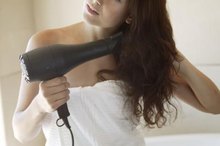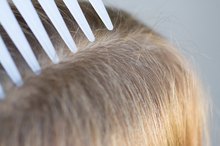What does fact checked mean?
At Healthfully, we strive to deliver objective content that is accurate and up-to-date. Our team periodically reviews articles in order to ensure content quality. The sources cited below consist of evidence from peer-reviewed journals, prominent medical organizations, academic associations, and government data.
- Tetracycline actions relevant to rosacea treatment
- Tetracycline actions relevant to rosacea treatment
The information contained on this site is for informational purposes only, and should not be used as a substitute for the advice of a professional health care provider. Please check with the appropriate physician regarding health questions and concerns. Although we strive to deliver accurate and up-to-date information, no guarantee to that effect is made.
How to Treat Hair Mites in Humans
Hair mites are most commonly found on a person's eyelashes and eyebrows, and don't usually cause any symptoms. However, in people with deficiencies in their immune system, they have been linked to various health conditions, including acne, dermatitis, rosacea, and hair loss.
Demodex folliculorum and dermodex brevis are the two main types of hair mites in humans. They live in the hair follicles, and in the sebaceous glands (oil glands) respectively. They are both refered to as demodicosis 1. Depending on which form of hair mite you have, and what symptoms the hair mites are producing on your face or in your hair, you can opt for a number of treatments for your demodicosis 1.
Hair Mites Treatment from your dermatologist
Visit your dermatologist. They will be able to diagnose what kind of hair mite you have by putting one of your eyelashes under a microscope.
How to Get Rid of Scabies in the Hair
Learn More
If you have hair mites, the dermatologist will lure them to the surface of the hair follicle with a chemical agent, and then treat your eyelids and brows with a 0.5% proparacaine solution. After five minutes, they will apply a solution of 70% alcohol.
Repeat these treatments at the dermatologist for three weeks.
Lice and Dreadlocks
Learn More
Continue to treat the hair mites at home in between visits to the dermatologist.
- They will be able to diagnose what kind of hair mite you have by putting one of your eyelashes under a microscope.
- If you have hair mites, the dermatologist will lure them to the surface of the hair follicle with a chemical agent, and then treat your eyelids and brows with a 0.5% proparacaine solution.
Home Treatments For Hair Mites
If you have a diagnosis of hair mites, discard all your eye makeup. Do not wear any during the duration of the treatment, approximately one month.
Disinfect all sheets and towels to prevent re-infection. Buy new pillows.
Check your domestic partner and children; if everyone has a hair mite problem, all will need to be treated.
Check pets for any signs of mange, and treat them accordingly.
Scrub the eyelids and eyebrows twice daily with baby shampoo diluted with water to yield a 50% dilution.
Apply 50% tea tree oil with 50% Macadamia nut oil carefully to the lashes and brows with cotton tip applicators. Get the oil into the lash roots and along the lashes to kill any eggs. Treat the eyebrows as well.
Apply the antibiotic ointment you have been prescribed until the symptoms clear up. Mercury oxide 1% ointment, pilocarpine gel, or tetracaine are the most common treatments for hair mites.
Use tea tree oil soap to wash your face daily.
Continue with all treatments until the symptoms disappear. A return trip the the dermatologist will determine if you have successfully removed your hair mites.
Tips
If inflammation is present, the dermatologist may prescribe a combination steroid-antibiotic ointment for one week.
If the hair mites have caused severe skin symptoms like acne or rosacea, oral antibiotics like tetracycline may be prescribed. Complete all doses of the ointments or oral antibiotics to clear the hair mites.
Tea tree oil is a natural antinflammatory with antiseptic properties, and excellent for discouraging acne.
Warnings
Be careful when applying any strong solution along the eyelashes.
Don't forget to treat the eyebrows as well.
For men, these treatments should include treating the facial hair, such as moustache, beard and sideburns. They might want to consider shaving facial hair closely.
- If you have a diagnosis of hair mites, discard all your eye makeup.
- Scrub the eyelids and eyebrows twice daily with baby shampoo diluted with water to yield a 50% dilution.
Related Articles
References
- Demodicosis: Treatment and Medication
- Demodex mites linked to human skin diseases
- Tetracycline actions relevant to rosacea treatment
- Phillips TG, Slomiany WP, Allison R. Hair Loss: Common Causes and Treatment. Am Fam Physician. 2017;96(6):371-378.
- Watras MM, Patel JP, Arya R. Traditional anticoagulants and hair loss: a role for direct oral anticoagulants? A review of the literature. Drugs Real World Outcomes. 2016;3(1):1-6. doi:10.1007/s40801-015-0056-z
- Urysiak-czubatka I, Kmieć ML, Broniarczyk-dyła G. Assessment of the usefulness of dihydrotestosterone in the diagnostics of patients with androgenetic alopecia. Postepy Dermatol Alergol. 2014;31(4):207-15. doi:10.5114/pdia.2014.40925
- Vincent M, Yogiraj K. A descriptive study of alopecia patterns and their relation to thyroid dysfunction. Int J Trichology. 2013;5(1):57-60. doi:10.4103/0974-7753.114701
- Peters EMJ, Müller Y, Snaga W, et al. Hair and stress: A pilot study of hair and cytokine balance alteration in healthy young women under major exam stress. PLoS ONE. 2017;12(4):e0175904. doi:10.1371/journal.pone.0175904
- Pratt CH, King LE, Messenger AG, Christiano AM, Sundberg JP. Alopecia areata. Nat Rev Dis Primers. 2017;3:17011. doi:10.1038/nrdp.2017.11
- American Academy of Dermatology. Alopecia Areata: Overview.
Tips
- If inflammation is present, the dermatologist may prescribe a combination steroid-antibiotic ointment for one week.
- If the hair mites have caused severe skin symptoms like acne or rosacea, oral antibiotics like tetracycline may be prescribed. Complete all doses of the ointments or oral antibiotics to clear the hair mites.
- Tea tree oil is a natural antinflammatory with antiseptic properties, and excellent for discouraging acne.
Warnings
- Be careful when applying any strong solution along the eyelashes.
- Don't forget to treat the eyebrows as well.
- For men, these treatments should include treating the facial hair, such as moustache, beard and sideburns. They might want to consider shaving facial hair closely.
Writer Bio
Since graduating from New York University with her Bachelor of Arts in 1996, Evelyn Trimborn has written both fiction and nonfiction for many websites and blogs on health, diet, nutrition, self-help, and business and finance. Her work has appeared on Amazon and at Healthful-Goddess.com, TreatAcneToday.com, InsiderSecretsCorp.com and Career-Command.com.








